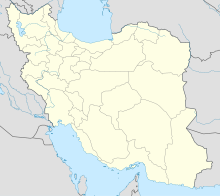Gundischapur
Coordinates: 32 ° 17 ′ 0 ″ N , 48 ° 31 ′ 0 ″ E
The city of Gundischapur (also Gondeschapur and Gondischapur , Persian گندی شاپور Gondi Schāpur , DMG Gondēšāpur , Middle Persian why-'andywk-shpwhry - "the better Antioch Shapur"; Syrian Beth-Lapat ) or Jondi Shapur (جُندی شاپور) is located south of the village of Schahadad in the north of today's Iranian province of Chuzestan , about 10 km southeast of Dezful . It was one of the most important, perhaps even the second largest, cities of the Sassanid Empire and the seat of the Academy of Gundischapur , a cultural and scientific center in pre-Islamic Persia.
history
The city was founded by Shapur I after the conquest of the Roman metropolis Antioch on the Orontes and also called Antioch Shapur , although there are indications that it is not a completely new establishment, but rather the renaming of an older city. Many deportees from Antioch were settled in the city. The city is said to have served as a Sassanid winter residence, especially under Shapur I. The captured Roman emperor Valerian probably also died in Gundischapur .
Gundishapur was the scene of numerous Christian and Manichaean martyrdoms. Here died Mani and the Catholicos shemon bar sabbae . The city was the seat of a metropolitan, in 484 the doctrine of Nestorios was established here at the synod of Beth-Lapat as binding for the Christians in the Persian Empire (see also Assyrian Church of the East ).
The city existed until the Islamic period, but lost its importance. The last bishop is attested in 1318.
archeology
The city has never been the target of major excavations. In 1963 the place was briefly examined during an inspection , which at least provided a rough idea of the former appearance of the city. The ruins lay on an area of approx. 3 × 2 km. The streets of the city were laid out like a chessboard, which may indicate a Greek foundation, perhaps also the work of the inhabitants of the city, who came from Antioch. This corresponds to the description of Persian geographers such as Hamzah al-Isfahani and Yaqut , who report that the city was crossed in its length and width by eight streets that met at right angles.
See also
- Academy of Gundischapur (there also further literature)
- Jondischapur University (since 1982 " Shahid-Tschamran University")
literature
- Heinz Herbert Schöffler: In the early modern period of Gondischapur. In: “gelêrter der arzeniê, ouch apotêker”. Contributions to the history of science. Festschrift for the 70th birthday of Willem F. Daems. Edited by Gundolf Keil , Horst Wellm Verlag, Pattensen / Hanover 1982 (= Würzburg medical-historical research, 24), ISBN 3-921456-35-5 , pp. 35-50.
- Daniel T. Potts: The Archeology of Elam . Cambridge University Press, Cambridge 1999, pp. 419-424, ISBN 0-521-56358-5 .
Web links
- Article on the city (English) at The Circle of Ancient Iranian Studies (CAIS)
- GONDĒŠĀPUR . In: Ehsan Yarshater (Ed.): Encyclopædia Iranica (English, including references)
- BĒṮ LAPAṬ . In: Ehsan Yarshater (Ed.): Encyclopædia Iranica (English, including references)
